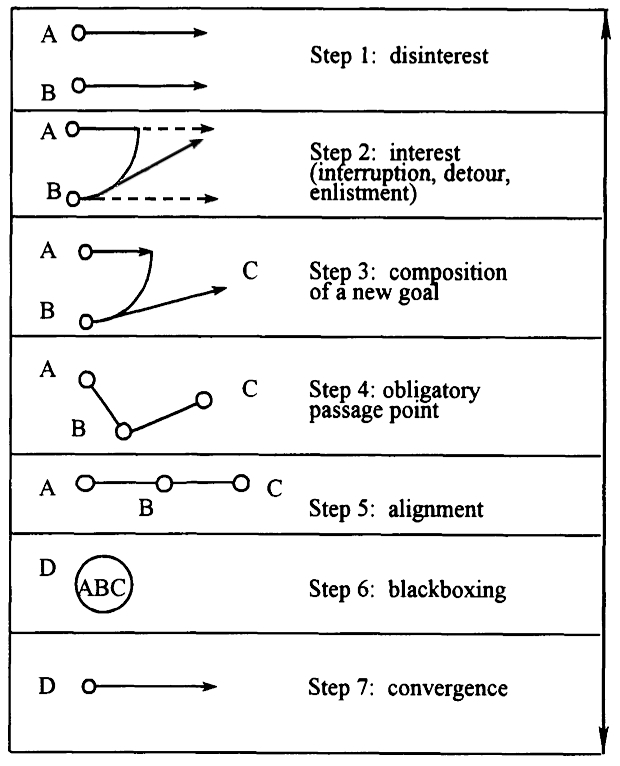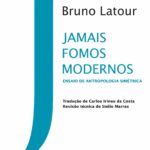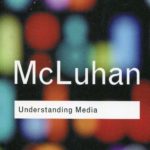
Mediação técnica (Latour 1994)
LATOUR, Bruno. 1994. On technical mediation: Philosophy, Sociology, Genealogy. Common Knowledge 3(2):29-64.
DAEDALION & TECHNOLOGY (desvio, estratégia, mediação e evolução-civilização):
No unmediated action is possible once we enter the realm of engineers and craftsmen. A daedalion, in Greek, is something curved, veering from the straight line, artful but fake, beautiful and contrived. […] Daedalus is our best eponym for technique – and the concept of daedalion our best tool to penetrate the evolution of civilization. (Latour 1994:29-30)
:::::::::: PHILOSOPHY :.
CRÍTICA A HEIDEGGER:
(Latour 1994:30)
GUNS KILL PEOPLE x PEOPLE KILL PEOPLE:
(Latour 1994:30-1)
FIRST MEANING OF MEDIATION: TRANSLATION (Fig.1):
A first sense of mediation […] is the program of action, the series of goals and steps and intentions, that an agent can describe in a story […] (fig. 1). If […] the accomplishment of the agent’s goal is interrupted, for whatever reason […], then the agent makes a detour, a deviation: […] one cannot speak of techniques without speaking of daedalia. Agent 1 falls back on Agent 2, here a gun. Agent 1 enlists the gun or is enlisted by it – it does not matter which – and a third agent emerges from a fusion of the other two. […] The question now becomes which goal the new composite agent will pursue. If it returns, after its detour, to Goal 1, then the […] gun is a tool, merely and intermediary. If agent 3 drifts from Goal 1 to Goal 2, than the […] gun’s intent, the gun’s will, the gun’s script have superseded those of Agent 1; it is human action that is no more than an intermediary. Note that in the diagram it makes no difference if Agent 1 and Agent 2 are reversed. The myth of the Neutral Tool under complete human control and the myth of the Autonomous Destiny that no human can master are symmetrical. But a third possibility is more commonly realized: the creation of a new goal that corresponds to neither agent’s program of action. […] I call this uncertainty about goals translation. […] Who, then, is the actor in my vignette? Someone else (a citizen-gun, a gun-citizen). […] You are a different person with the gun in your hand. Essence is existence and existence is action. If I define you by what you have (the gun), and by the series of associations that you enter into when you use what you have (when you fire the gun), then you are modified by the gun – more so or less so, depending on the weight of the other associations that you carry. This translation is wholly symmetrical. You are another subject because you hold the gun; the gun is another object because it has entered into a relationship with you. The gun is no longer the gun-in-the-armory or the gun-in-the-drawer or the gun-in-the-pocket, but the gun-in-your-hand, aimed at someone who is screaming. What is true of the subject, of the gunman, is as true of the object, of the gun that is held. […] Neither subject nor object (nor their goals) is fixed. […] It is neither people nor guns that kill. Responsibility for action must be shared among the various actants. And this is the first of the (four) meanings of mediation. (Latour 1994:31-4)
TRANSLATION (Serres e Callon): (Latour 1994:32 nota 3)
Like Michel Serres, I use translation to mean displacement, drift, invention, mediation, the creation of a link that did not exist before and that to some degree modifies two elements or agents. (Latour 1994:32)
ACTANTS (agents) & PROGRAMS OF ACTION (goals-functions):
Agents can be human or […] nonhuman, and each can have goals (or functions, as engineers prefer to say). Since the word agent in the case of nonhumans is uncommon, a better term is actant, a borrowing from semiotics that describes any entity that acts in a plot until the attribution of a figurative or nonfigurative role […]. A single actant may take many different “actantial” shapes, and conversely the same actor may play many different “actorial” roles. The same is true of goals and functions, the former associated more with humans, the latter with nonhumans, but both can be described as programs of action – a neutral term useful when an attribution of human goals or nonhuman functions has not been made. (Latour 1994:33-4)
GOALS or FUNCTIONS?
That depends on the degree of anthropomorphism involved. (Latour 1994:34)
ACTOR-NETWORK:
[T]he prime mover of an action becomes a new, distributed, and nested series of practices whose sum might be made but only if we respect the mediating role of all the actants mobilized in the list. (Latour 1994:34)
SECOND MEANING OF MEDIATION: COMPOSITION (Fig. 2)
Action is a property of associated entities. Agent 1 is allowed, authorized, enabled by the others. […] The attribution to one actor of the role of prime mover in no way weakens the necessity of a composition of forces to explain the action. It is by mistake, or unfairness, that our headlines read, “Man flies,” “Woman goes into space.” Flying is a property of the whole association of entities that includes airports and planes, lauch pads and ticket counters. B-52s do not fly, the U.S. Air Force flies. Action is simply not a property of humans but of an association of actants, and this is the second sense of what I intend by technical mediation. (Latour 1994:35)
SYMMETRY:
Any given symmetry is defined by what is conserved through transformations. In the symmetry between humans and nonhumans, I keep constant the series of competences, of properties, that agents are able to swap by overlapping each other. (Latour 1994:35)
HOMO FABER (Hegel, Leroi-Gourhan, Marx, Bergson):
(Latour 1994:35)
THIRD MEANING OF MEDIATION: REVERSIBLE BLACKBOXING (Fig.3)
Look around the room in which you are puzzling over figure 3. Consider how many black boxes there are in the room. Open the black boxes; examine the assemblies inside. Each of the parts inside the black box is a black box full of parts. If any part were to break, how many humans would immediately materialize around each? How far back in time, away in space, should we retrace our steps to follow all those silent entities that constribute peacefully to your reading this article at your desk? Return each of these entities to step 1; imagine the time when each was disinterested and going its own way, without being bent, enrolled, enlisted, mobilized in any of the others’ plots. (Latour 1994:36-7)
FOURTH MEANING OF MEDIATION: DELEGATION (speed bumps) (Fig.4)
The copresence of enunciators and enunciatees has collapsed along with frames of reference. An object stands in for an actor and creates an asymmetry between absent makers and occasional users. Without this detour, this shifting down, we would not understand how an enunciator could be absent: Either it is there, we would say, or it does not exist. But by shifting down, another combination of absence and presence becomes possible. It is not, as in fiction, that I am here and elsewhere, that I am myself and someone else, but that action, long past, of an actor, long disappeared, is still active here, today, on me – I live in the midst of technical delegates. […] Think of technology as congealed labor. Consider the very notion of investment: A regular course of action is suspended, a detour is initiated via several types of actants, and the return is a fresh hybrid that carries past acts into the present and permits its many makers to disappear while also remaining present. […] The speed bump is not made of matter, ultimately; it is full of engineers and chancellors and lawmakers, commingling their wills and their story lines with those of gravel, concrete, paint, and standard calculations. (Latour 1994:40-1)
BLIND SPOT:
The mediation, the technical translation, that I am trying to understand resides in the blind spot where society and matter exchange properties. [….] I am struggling to approach the zone where some, though not all, of the characteristics of concrete become policemen, and some, though not all, of the characteristics of policemen become speed bumps. . . (Latour 1994:41)
RELOCATE HUMANISM:
We must learn to ignore the definitive shapes of humans, and of the nonhumans with which we share more and more of our existence. The blur that we would then perceive, the swapping of properties, is a characteristic of our premodern past, in the good old days of poiesis, and a characteristic of our modern and nonmodern present as well. (Latour 1994:42)
:::::::::: SOCIOLOGY :.
KUBRICK’S “2001: A space odissey”
Were scholarship as efficient as the art of film, I would have you progress as rapidly as Kubrick’s apes – from a band of primates linked only by social ties to a evolved species of sociotechnical humans who admit their inferiolr brethren, the nonhumans, to their social thinking. But to bring this about would be quite a miracle, since social theory is as devoid of artifacts as were Kubrick’s apes before the monolith arrived. (Latour 1994:43)
VARIOUS MEANINGS OF THE ADJECTIVE TECHNICAL
It designates, first, a subprogram, or a series of nested subprograms […]. When we say “this is a technical point,” it means that we have to deviate for a moment from the main task and that we will eventually resume our normal course of action, which is the only focus worth our attention. A black box opens momentarily, and will become black again, completely invisible in the main sequence of action. (Latour 1994:43)
Second, technical designates the subordinate role of people, skills, or objects that occupy this secondary function of being present, indispensable, but invisible. It thus indicates a specialized and highly circumscribed task, clearly subordinate in a hierarchy. (Latour 1994:43)
Third, the adjective designates a hitch, a snag, a catch, a hiccup in the smooth functioning of the subprograms, as when we say that “there is a technical problem to solve first”. Here, the deviation might not lead us back to the main road, as with the first meaning, but may threaten the original goal entirely. Technical is no longer a mere detour, but an obstacle, a roadblock. What should have been a means, may become an end, at least for a while. (Latour 1994:43)
The fourth meaning carries with it the same uncertainty about what is an end and what is a means. […] Technical people, objects, or skills are at once inferior (since the main task will be resumed), indispensable (since the goal is unreachable without them), and, in a way, capricious, mysterious, uncertain (since they depend on some highly specialized and badly circumscribed knack). […] So the adjective technical has a useful meaning that maps in the language the three first types of translation that I defined above. (Latour 1994:43-4)
Technical also designates a very specific type of delegation, of movement, of shifting, that crosses over with entities that have different timing, different properties, different ontologies, and that are made to share the same destiny, thus creating a new actant. Here the noun is often used as well as the adjective, as when we say “a technique of communication,” a technique for boiling eggs.” In this case, the noun does not designate a thing, but a modus operandi, a chain of gestures and know-how, bringing about some anticipated result. (Latour 1994:44)
TECHNICAL SKILL:
Technical skill is not a thing we can study directly. We can only observe its dispersal among various types of actants. […] Technical skill is not uniquely possessed by humans and reluctantly granted to nonhumans. Skills emerge in the zone of transaction, they are properties of the assembly that circulate or are redistributed among human and nonhuman technicians, enabling and authorizing them to act. (Latour 1994:44-5)
TECHNICAL ACTION FOLDS TIME (irreversibility):
Even my own action of a moment ago is now foreign to me, though still present in a new guise. Through my productive detour, my investment, a relative irreversibility is set in place. (Latour 1994:45)
PERSONNE MORALE, CORPORATE BODY, ARTIFICIAL PERSON:
If ever one comes face to face with an object, that is not the beginning but the end of a long process of proliferating mediators, a process in which all relevant subprograms, nested on into another, meet in a “simple” task (Latour 1994:45)
HUMAN EXISTENCE=ACTION:
There is no sense in which humans may be said to exist as humans without entering into commerce with what authorizes and enables them to exist (i.e., to act). (Latour 1994:45-6)
SOCIOLOGY OF OBJECTS:
an object is a subject that only sociology can study (Latour 1994:46)
BOING x AIRLINES
Boeing-747s do not fly, airlines fly. (Latour 1994:46)
THE NEW PARADIGM (Fig.6)
In the newly emerging paradigm (fig. 6), we substitute collective – defined as an exchange of human and nonhuman properties inside a corporate body – for the tainted word society. […] First there is translation, the means by which we inscribe in a different matter features of our social order; next, the crossover, which consists in the exchange of properties among nonhumans; third, the enrollment, by which a nonhuman is seduced, manipulated, or induced into the collective; fourth, the mobilization of nonhumans inside the collective, which adds fresh unexpected resources, resulting in strange new hybrids; and, finally, displacement, the direction the collective takes once its shape, extent, and composition have been altered. (Latour 1994:46)
MODERNS & NON-MODERNS
The difference between an ancient or “primitive” collective and a modern or “advanced” one is not that the former manifests a rich mixture of social and technical culture while the latter exhibits a technology devoid of ties with the social order. The difference, rather, is that the latter translates, crosses over, enrolls, and mobilizes more elements, more intimately connected, with a more finely woven social fabric than the former does. The relation between the scale of collectives and the number of nonhumans enlisted in their midst is crucial. One finds, of course, longer chains of action in “modern” collectives, a greater number of nonhumans (machines, automatons, devices) associated with one another, but one must not overlook the size of markets, the number of people in their orbits, the amplitude of the mobilization: more objects, yes, but many more subjects as well. […] Objects and subjects are made simultaneously, and an increased number of subjects is directly related to the number of objects stirred – brewed – into the collective. (Latour 1994:47)
O CASO “ARAMIS”
(Latour 1994:48-9)
DURKHEIM x SOCIOGENESIS:
(Latour 1994:49-50)
ETHNOMETHODOLOGY
(Latour 1994:50)
RECONCILING ETHNOMETHODOLOGY & MAINSTREAM SOCIOLOGY:
The new paradigm I am proposing for the study of techniques obviates these disputes. Let us admit that the ethnomethodologists are right, that there exist only local interactions, producing social order on the spot. And let us admit that mainstream sociologists are right, that actions at a distance may be transported to bear on local interactions. How can gthese positions be reconciled? An action in the distant past, in a faraway place, by actors now absent, can still be present, on condition that it be shifted, translated, delegated, or displaced to other types of actants, those I have been calling nonhumans. […] When we say that “we” here present are engaged in our local interactions, the sum of those who are summoned must include all the other personae that have been shifted down previously. “We” is not a simple synoptic and coherent category. The notion of a present and local interaction is subverted by an immense crowd of nonhumans, each determined by its own shifts in time, space, and actant. […] Of course, ethnomethodologists are right to criticize traditional sociology with its fanciful macro level, but they are wrong to conclude that there is such a thing as an absolutely local interactions. No human relationship exists in a framework homogeneous as to space, time, and actants. However, the error that traditional sociology makes is as great, when it forgets to ask how a difference of scale is obtained, how power is exerted, irreversibility sets in, and roles and functions are distributred. Everything in the definition of macro social order is due to the enrollment of nonhumans – that is, to technical mediation. Even the simple effect of duration, of long-lasting social force, cannot be obtained without the durability of nonhumans to which human local interactions have been shifted. (Latour 1994:50-1)
:::::::::: GENEALOGY :.
KENYA BABOON SOAP OPERA:
(Latour 1994:51-2)
TECHNICAL ACTION as DELEGATION:
Technical actino is a form of delegation that allows us to mobilize, during interactions, moves made elsewhere, earlier, by other actants. It is the presence of the past and distant, the presence of nonhuman characters, that frees us, precisely, from interactions (what we manage to do, right away, with our humble social skills). That we are not Machiavellian baboons we owe to technical action. (Latour 1994:52)
TECHNIQUE as SOCIALIZATION OF NONHUMANS:
The traditional definition of technique as the imposition of a form consciously planned onto shapeless matter should be replaced by a view of technique – a more accurate view – as the socialization of nonhumans. (Latour 1994:52-3)
SOCIETY IS NOS SOCIALLY CONSTRUCTED
Society is not stable enough to inscribe itself in anytyhing. On the contrary, most of the features of what we mean by social order – scale, asymmetry, durability, power, hierarchy, the distributino of roles – are impossible even to define without recruiting socialized nonhumans. Yes, society is constructed, but not socially constructed. (Latour 1994:53)
SHARING RESPONSIBILITY & REDIFINING HUMANITY:
Responsibility for action must be shared, symmetry restored, and humanity redescribed: not as the sole transcendent cause, but as the mediating mediator. (Latour 1994:54)
GENEALOGY OF SOCIOTECHNICAL ASSOCIATIONS:
What needs to be done, then, is to peel away, one by one, the layers of meaning and attempt a genealogy of their associations. (Latour 1994:54)
ASSOCIATION SPACE
It should be possible to imagine a space, that could be studied empirically, in which we could observe the swapping of properties without having to start from a priori definitions of humanity.(Latour 1994:54)
POLITICAL ECOLOGY (Level 11)
We have literally, not symbolically as before, to manage the planet we inhabit, and must now define a politics of things. (Latour 1994:55)
TECHNOLOGIES (Level 10)
While on this model […], automata have no rights, they are much more than material entities; they are complex organizations. (Latour 1994:56)
NETWORKS OF POWER (Level 9)
What can be done with electrons can be done with electors. (Latour 1994:57)
SWAPPING
[T]he point of my little genealogy is also to identify, inside the seamless web, properties borrowed from the social world in order to socialize nonhumans, and, vice versa, borrowed from nonhumans in order to naturalize and expand the social realm. For each layer of meaning, whatever happens happens as if we were learning, in contact with one side,ontological properties that are then reimported to the other side, generating new, completely unexpected effects (Fig. 7). (Latour 1994:56-7)
INDUSTRY (Level 8)
The extraordinary feat of what I will call industry is to extend to matter a further property that we think of as exclusively social, the capacity to relate to other sof one’s kind. Nonhumans have this capacity when part of the assembly of actants that we call a machine: an automaton endowed with autonomy of some sort and submitted to regular laws that can be measured with instruments and accounting procedures. From tools held in the hands of human workers, the shift historically was to assemblies of machines, where tools relate to one another, creating a massive array of labor and material relations in factories that Marx described as so many circles of hell. The paradox of this stage of relations between humans and nonhumans is thbat it has been termed “alienation”, dehumanization, as if it were the first time that poor and exploited human weakness was confronted wihtan all-powerful objective force. however, to relate nonhumans together in an assembly of amachines, ruled by laws, and accounted for by instruments, is to grant them a sort of social life. […] The “megamachine” […] has been extended to nonhumans. (Latour 1994:58)
MATTER:
Far from being primitive, immutable, and ahistorical, matter has a complex genealogy. […] Matter is not a given, but a recent historical creation. (Latour 1994:58)
MODERNITY:
Indeed,the mopdernits project consists in creating that peculiar hybrid: a fabricated nonhuman that has nothing of the charecter of society and politics yet builds the body politic all the more effectively because it seems completely estranged from humanity. (Latour 1994:58)
THE MEGAMACHINE (Level 7)
Before it is possible to delegate action to nonhumans, and possible to relate nonhumans to one another in an automaton, it must first be possible to nest a range of subprograms for action into one another without losing track of them. Management, Mumford would say, precedes the expansion of material techniques. (Latour 1994:59)
EVEN & ODD
The even-numbered episodes I have recounted so far follow this pattern: industry shifts to nonhumans the management of people learned in the imperial machine, much as technologies shift to nonhumans the large-scale management learned through networks of power. In the odd-numbered episodes, the opposite process is at work: what has been learned from nonhumans is reimported so as to reconfigure people. (Latour 1994:59)
INTERNALIZED ECOLOGY (Level 6)
agriculture and the domestication of animals. The intense socialization, reeducation, and reconfiguration of plants and animals – so intense that they change shape, function, and often genetic makeup (Latour 1994:60)
SOCIETY (Level 5)
What Durkheim mistook for the effect of a sui generis social order is simply the effect of having brought so many techniques to bear on our social relations. It was from techniques that we learned what it means to subsist and distend, to accept a role and discharge a function. By reimporting this competence into the definition of society, we taught ourselves to reify it, to make society stand independent of fast-moving interactions. We even learned how to delegate to society the task of relegating us to roles and functions. Society exists, in other worlds, but is not socially constructed. Nonhumans proliferate below the bottom line of social theory. (Latour 1994:60)
TECHNIQUES (Level 4)
By this stage in our speculative genealogy, we can no longer talk of humans, of anatomically modern humans, but only of social prehumans. At last, we are in a position to define technique with some precision. Techniques, we learn from archaeologists, are articulated subprograms for actions that subsist (intime) and extend (in space). Techniques imply not society (that late-developing hybrid) but a semisocial organization that brings together nonhumans from very different seasons, places, and materials. A bow and arrow, a javelin, a hammer, a net, an article of clothing are composed of parts and pieces that require recombination in sequences of time and space that bear no relation to their natural settings. Techniques are what happen to tools and nonhumans actants when processed through an organization that extracts, recombines, and socializes them. Even the3 simplest techniques are sociotechnical; even at this primitive level of meaning, forms of organization are inseparable from technical gestures. (Latour 1994:61)
SOCIAL COMPLICATION (Level 3)
[A]t this stage there is no society, no overarching framework, no dispatcher of roles and functions; merely interactions among prehumans. […] Complex interactions are now marked and followed by nonhumans enrolled for the purpose. Why? Nonhumans stabilize social negotiatins. Nonhumans are at once pliable and durable; they can be shaped very quickly but, once shaped, last far longer than the interactions that fabricated them. Social interactions are extremely labile and transitory. More precisely, either htey are negotiable but transient or, if they are encoded (for instance) in the genetic makeup, they are extremely durable but difficult to renegotiate. By involving nonhumans, the contradiction between durability and negotiability is resolved. It becomes possible to follow (or “black box”) interactions, to recombine highly complicated tasks, to nest subprograms into one another. What was impossible for complex social animals to accomplish becomes possible for prehumans – who use tools, not to acquire food but to fix, underlyne, materialize, and keep track of the social realm. Though composed only of interactions, the social realm becomes visible and attains through the enlistment of nonhumans – tools – some measure of durability. (Latour 1994:61)
THE BASIC TOOK KIT (Level 2)
What, then, is a tool? The extension of social skills to nonhumans. […] [T]reating a stone, say, as a social partner, modifying it, then acting on a second stone. Prehuman tools, in contrast to the ad hoc implements of other primates, represent the extension of a skill rehearsed in the realm of social interactions. (Latour 1994:62)
SOCIAL COMPLEXITY (Level 1)
Garfinkelian interactinos to repair a constantly decaying social order. (Latour 1994:62)
SOCIOTECHNICAL
My little origin myth makes conceivable the impossibility of an artifact that does not incorporate social relations, and makes conceivable the impossibility of defining social structures without accounting for the large role of nonhumans in them. […] In place of the great vertical dichotomy between society and techniques, there is conceivable (in fact, now, available) a range of horizontal distinctions between very various meanings of the sociotechnical hybrids. It is possible to have our cake and eat it – to be monists and make distinctions. (Latour 1994:62)
To conceive humanity and technology as polar is to wish away humanity: we are sociotechnical animals, and each human interaction is sociotechnical. We are never limited to social ties. We are never faced with objects. This final diagram (fig. 8) relocates humanity where we belong – in the crossover, the central column, the possibility of mediating between mediators. (Latour 1994:64)
THE ILLUSION OF MODERNITY:
(Latour 1994:64)
OBJECTIVITY & SUBJECTIVITY:
Objectivity and subjuectivity are not opposed, they grow together, and they grow irreversibly together. (Latour 1994:64)
THEY ARE US
They [artifacts] mediate our actions? No, they are us. (Latour 1994:64)





 O LaSPA é sediado no Instituto de Filosofia e Ciências Humanas (
O LaSPA é sediado no Instituto de Filosofia e Ciências Humanas (